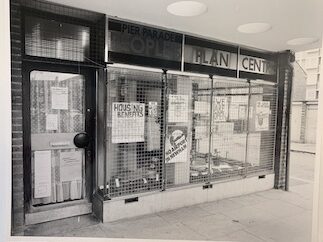
The project set out to explore hidden or previously overlooked histories of community-led planning (CLP) since the 1960s. As happens with many social research projects, however, a first challenge was to define what we meant by CLP.
In the initial phases of the project we conducted 24 ‘scoping interviews’ with key figures we identified as having had long standing involvement with community campaigns and planning over time. One of our key questions was how we could define or understand what we mean by CLP, the variety of answers they gave us provides some insight into the complexities of the task.
“My definition of community[-led] planning is where communities can make a difference you know as far as where they can influence the outcome of things, which is where they have the power to sort of make things different that can actually benefit them in a way that might otherwise not happen.”
“…it is a contested concept and one that is shaped by you know concrete practices of different players at different times um so …I think that’s a very waffly answer probably but I think it it does mean that there’s very fuzzy edges around it and quite different things can be done by quite different players at different times all within that heading”
“Well I’m never very interested in definitions and certainly you can’t viably start developing a definition of something until it has a fairly stable existence as a body of practice or a set of phenomena and I would I would say there isn’t anything established as community-led planning…”
“It can be whatever you want it to be – it is a set of political assumptions – you can’t really define it other than by who is leading it and what its objectives are. But maybe you could say it is about representation, voice, active participation and control/power.”
“You’ve got… people not happy with the planning system as it presents and the canny thing if they are clever is to try to find ways of delivering what they want, again sometimes completely against, sometimes marginally against, sometimes with the system just finding a loophole that no one has recognized. So for me community-led is all of that spectrum equally”
How we define planning matters a great deal. As planning theorist Leonie Sandercock has said, “The boundaries of planning history are not a given. These boundaries shift in relation to the definition of planning (as both ideas and practices) and in relation to the historian’s purpose. If we define planning as bounded by the profession, and its objective as city-building, then we generate one set of histories. If we define planning as community-building, we generate another…in emphasizing planning as a regulatory or disciplinary practice, we may miss its transformative possibilities…” (Sandercock, 1998, 36).
For many people in the UK, the term planning is now synonymous with local government bureaucracy and the complicated statutory system of land use controls they manage. From the late 1960s onwards the public have been granted formal opportunities to participate in this system. Much of the focus on the role of ordinary people in planning has therefore been on the ways these spaces either do (or do not) create the conditions for more inclusive planning.
However, this is a very narrow definition that risks editing a huge range of important community planning initiatives out of the picture. One of the reasons that formal mechanisms for public participation were introduced in the first place was the emergence of organised action groups who challenged the dominance of experts, the state and property developers and campaigned for communities to have greater influence over the ways their environments were changing. These groups often demanded more power through formal channels of participation but they also drew up their own alternative plans, took direct control of land and buildings (sometimes illegally), and developed a wide range of projects and initiatives to better meet their needs, from adventure playgrounds to community enterprises and collective housing. For some people these efforts are part of a longer tradition that tracks back to utopian community building initiatives in earlier periods.
Debates in planning theory have long recognised community-led activities as significant forms of planning, with the potential to generate new political possibilities. In this project we have tried to bring this wider definition to understandings of planning history in the UK, reconnecting with long-standing but often neglected traditions of planning as a social movement and form of direct, collective action.
By broadening our understanding of planning to include this wider range of activity, we can begin to see participatory planning as an integral part of much broader forms of community action and local political organising. Sometimes this can make it hard to draw a boundary around CLP initiatives, as another of our respondents suggested:
“I think perhaps i’d also say that some of the issues and campaigns that i’ve been involved with wouldn’t have described themselves as being about community-led planning. They would be about campaigning for affordable housing or campaigning for community amenities rather than planning per se. I started getting involved in Notting Hill in the late 60s which is around (her) housing survey. And again i think that was an example where the issue was shocking housing and very deprived communities rather than planning per se”
Despite this, we think adopting a looser definition helps to create a richer understanding of the diverse and creative ways that people have come together to collectively shape their futures. In doing so, we ask planning theory, practice and education to grapple with the challenges, potentialities and limitations of informal, community-led planning.